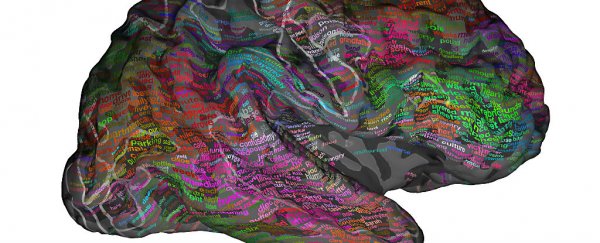You probably know that the human brain is made up of many different regions, with the main structures - the cerebrum, cerebellum, limbic system, and brain stem - all broken up into smaller sections that perform certain types of functions.
For example, the frontal lobe of the cerebrum is associated with reasoning, speech, movement, emotions, and problem-solving, while the two hemispheres of the cerebellum take care of our physical coordination, posture, and balance.
But there's no single brain region that processes and stores all the words and concepts in our vocabulary. Language, as it turns out, is processed all over the brain, and it's organised so meticulously that scientists have been able to pinpoint exactly which regions store specific words - even if they have more than one meaning.
For example, when you hear the word "top", a small area in the middle frontal gyrus region of your brain will light up. But this isn't the only part of your brain that responds to "top" - depending on the context in which it was used, the region responsible for words associated with clothing and appearance might light up, or the region associated with numbers and measurements, or buildings and places.
Yep, your brain is so clever, that it uses neurons in just about every pocket and fold to organise the meaning of words into logical groups, so words like "mother", "father", "pregnant", and "family" appear to be processed in the same area, and the region just next door, lights up in repose to related words such as "house", "owner" and "landlord".
You can see all of this in action in the video below, which represents the new 'brain atlas' compiled by neuroscientists at the University of California, Berkeley:
"Our goal was to build a giant atlas that shows how one specific aspect of language is represented in the brain, in this case semantics, or the meanings of words," one of the team, Jack Gallant, told Ian Sample at The Guardian.
In the video, you can see that the brain doesn't just group together specific words depending on their meaning - for example, "stripes", "spots" and "colours" are processed in a certain area of the visual cortex - the brain also groups together much bigger categories too. So the words represented in green are mostly visual and tactile, while the red words are mostly social.
The team managed to create this incredible resource by recording the brain activity of seven volunteers (five men, two women) as they listened to stories from a US radio show called The Moth Radio Hour. Once they had the scans, the researchers played the transcripts back and matched up to 80,000 pea-sized spots on the cerebral cortex that lit up as each word was spoken.
Over the course of the two-hour radio show, each participant ended up hearing around 25,000 words in total, 3,000 of which were unique.
And while seven is an incredibly tiny sample size, what's striking is the fact that while each brain atlas was unique, they were all remarkably similar in terms of where their brains grouped certain words.
"For example, on the left-hand side of the brain, above the ear, is one of the tiny regions that represents the word 'victim'," says Sample. "The same region responds to 'killed', 'convicted', 'murdered', and 'confessed'. On the brain's right-hand side, near the top of the head, is one of the brain spots activated by family terms: 'wife', 'husband', 'children', 'parents'."
Interestingly, certain 'loaded' words made the brain respond more strongly than others. "The idea of murder is represented a lot in the brain," says Gallant.
It should be noted that all of the volunteers were native English speakers, so a much larger and more diverse sample size, including bilingual participants and those who speak a different language, could reveal some important differences.
The researchers are going to continue to refine their 'brain atlas;, and we could soon see it being used in pretty incredible ways. "One potential use would be a language decoder that could allow people silenced by motor neurone disease or locked-in syndrome to speak through a computer," says Sample.
"It is possible that this approach could be used to decode information about what words a person is hearing, reading, or possibly even thinking," one of the researchers, Alexander Huth, told him.
The results of the study have been published in Nature, and the scientists have created an interactive website where you can explore the brain atlas yourself. Check it out here, and have your mind blown by, well, your mind.
